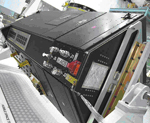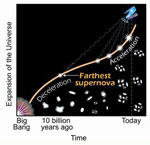 Overview
Overview
The Instrument
Scientific Future of ACS
The Advanced Camera for Surveys (ACS) was installed on Hubble during Servicing Mission 3B in 2002. An electronics failure in January, 2007 rendered inoperable the two most-used science channels, and ACS currently runs on one remaining channel. A repair attempt by space-walking astronauts during SM4 will specifically target restoration of the Wide Field Channel (WFC), the workhorse responsible for 70% of the pre-2007 ACS science. The goal, however, is to restore both of the inoperable channels while preserving the third, bringing ACS back to full capability.
Instrument and Repair Overview
Many of the most extraordinary images from Hubble were taken with the ACS Wide Field Channel (WFC), most famously perhaps the Hubble Ultra Deep Field, still the deepest, most detailed look into the early Universe after galaxies had begun to form.

Hubble Deep Field
|

Close-up of a small portion |
The High Resolution Channel (HRC) provided higher angular resolution over a smaller field-of-view, and it included an option for corona-graphic imaging of faint objects around bright stars. The Solar-Blind Channel (SBC)-the one channel still working-was designed to provide small field-of-view imaging in the far ultraviolet region of the spectrum. Following its installation on Hubble, the ACS became the observatory's most heavily used instrument.
To increase scientific longevity, Hubble instruments are designed to be electrically redundant. The January 2007 failure was actually on electronics "Side 2," an earlier power supply failure in 2006 having made Side 1 unable to operate WFC and HRC. With the high currents it generated, the Side 2 short circuit was very energetic, but it was not precisely localized to a particular component part. The failure took down operations on all three science channels, and the SBC is currently running on the portions of Side 1 that were unaffected by the 2006 event. Because of the certainty of greater damage to Side 2 and the more precise knowledge of what happened on Side 1, the Hubble Program settled on Side 1 as offering the greater chance for successful repair.
To restore WFC and HRC, power not now available must somehow be provided to their control electronics. Because neither the partially failed Side 1 power supply nor the cabling which connects it to the control electronics is accessible to the astronauts, direct repair is not possible and a two-pronged alternative approach must be taken.  The electronics boards that control WFC are accessible and will be replaced with modified boards. Second, a completely new power supply will be mounted to a handrail outside of ACS (right) and mated to the new electronics with external cabling.
HRC also has accessible electronics boards, but there is not enough EVA time available on the mission to allow replacement of the boards for both the WFC and HRC channels. However, inside ACS is wiring connecting the WFC and HRC electronics boxes which is believed to be intact, and by driving the new WFC electronics boards with the external power supply, it is expected, but not guaranteed, that the HRC will be "back-powered" and become operable. The electronics boards that control WFC are accessible and will be replaced with modified boards. Second, a completely new power supply will be mounted to a handrail outside of ACS (right) and mated to the new electronics with external cabling.
HRC also has accessible electronics boards, but there is not enough EVA time available on the mission to allow replacement of the boards for both the WFC and HRC channels. However, inside ACS is wiring connecting the WFC and HRC electronics boxes which is believed to be intact, and by driving the new WFC electronics boards with the external power supply, it is expected, but not guaranteed, that the HRC will be "back-powered" and become operable.
Astronauts will access the WFC electronics by removing a small panel outside the instrument. They must remove and replace four boards, for which special tools have been developed.  To reduce repair time, a cartridge (left) will hold the replacement boards and be mated into the electronics box with a single action. The new boards in their cartridge must be smaller than the originals. The new design incorporates a specialized integrated circuit called an Application-Specific Integrated Circuit, or ASIC, that enables an entire circuit board's worth of electronics to be condensed into a very small package. A great strength of this approach is that the ASIC can be completely re-programmed by commands from controllers on the ground, and the WFC can be fine-tuned for best performance. The ASIC design is the same as the one already developed and tested for the James Webb Space Telescope (to be launched in 2013), although the electronics packaging is different because of the dissimilar environments for the two missions. To reduce repair time, a cartridge (left) will hold the replacement boards and be mated into the electronics box with a single action. The new boards in their cartridge must be smaller than the originals. The new design incorporates a specialized integrated circuit called an Application-Specific Integrated Circuit, or ASIC, that enables an entire circuit board's worth of electronics to be condensed into a very small package. A great strength of this approach is that the ASIC can be completely re-programmed by commands from controllers on the ground, and the WFC can be fine-tuned for best performance. The ASIC design is the same as the one already developed and tested for the James Webb Space Telescope (to be launched in 2013), although the electronics packaging is different because of the dissimilar environments for the two missions.
+ Back to Top
The Instrument
WFC and HRC have Charge Coupled Devices (CCDs) for detectors. WFC has a 4k x 4k pixel format created by two adjacent 2k x 4k devices. The CCDs were optimized for sensitivity in the red region of the spectrum, and spectral coverage extends from about 3500 Angstroms (Å) in the blue, up beyond the visible-red to 1.1 microns (11,000Å). The field of view is 202 x 202 arcseconds (arcsec).
HRC's CCD has smaller pixels in a 1k x 1k format. With sensitivity from 1700Å to 1.1 microns, HRC has greater spectral range than WFC. The field of view is 26 x 29 arcsec. Within HRC is a coronagraph that can place either of two opaque disks in front of stars so that nearby faint objects, e.g., brown dwarf companions, giant planets, or dusty disks, can be shielded from the stellar glare and be seen.

ACS Charge Coupled Device (CCD) |

ACS Multi-Anode Microchannel Array (MAMA) |
In the far ultraviolet, SBC uses a Multi-Anode Microchannel Array (MAMA), also used by the Space Telescope Imaging Spectrograph (STIS) on Hubble. MAMAs are insensitive to visible light and have essentially no electronic noise. SBC has a 1k x 1k pixel format, a field of 31 x 35 arcsec, and sensitivity from 1150 to 1700Å. All the detector channels employ selectable filters mounted on rotating filter wheels to transmit the desired color of light to the detector for any particular image.
+ Back to Top
Scientific Future of ACS
Many scientific programs originally planned for ACS can be continued with WFC3. However, there are especially important areas for which the teaming of a restored ACS and WFC3 would be especially well-suited, two examples being:
- Dark Energy - The nature of Dark Energy, the mysterious "repulsive gravity" that causes accelerating expansion of the local universe, is one of the most compelling problems in contemporary physics.
 Dark Energy can be probed with Hubble through observations of Type Ia supernovae, which because of their well-understood intrinsic brightness can be used to trace the expansion history of the universe over a sizable fraction of cosmic time. The more SNIa's that can be observed, the more precise becomes our understanding of Dark Energy's strength and time variability (if any). ACS and WFC3 working in parallel would detect and make follow-up observations substantially more rapidly than WFC3 alone. ACS has already proven its remarkable capabilities in the efficient detection of distant supernovae. Dark Energy can be probed with Hubble through observations of Type Ia supernovae, which because of their well-understood intrinsic brightness can be used to trace the expansion history of the universe over a sizable fraction of cosmic time. The more SNIa's that can be observed, the more precise becomes our understanding of Dark Energy's strength and time variability (if any). ACS and WFC3 working in parallel would detect and make follow-up observations substantially more rapidly than WFC3 alone. ACS has already proven its remarkable capabilities in the efficient detection of distant supernovae.
- Dark Matter - Approximately 24% of the universe's matter and energy budget consists of a not-understood form of matter that neither emits nor absorbs light (hence is "dark"),
 and can only be detected by its gravitational influence on normal matter and light. By taking many images over large areas of sky ("tiling"), ACS has shown that the slight distortion of distant galaxy shapes produced by dark matter through "gravitational lensing" can be used to measure the amount and distribution of the dark matter in the universe. ACS and WFC3 working together would be a formidable team in this crucial area that, in spite of ACS's tremendous work to-date, is still in its infancy. and can only be detected by its gravitational influence on normal matter and light. By taking many images over large areas of sky ("tiling"), ACS has shown that the slight distortion of distant galaxy shapes produced by dark matter through "gravitational lensing" can be used to measure the amount and distribution of the dark matter in the universe. ACS and WFC3 working together would be a formidable team in this crucial area that, in spite of ACS's tremendous work to-date, is still in its infancy.
+ Back to Top |